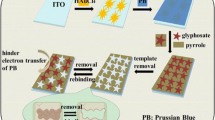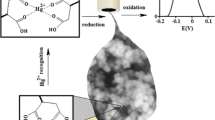Abstract
An electrochemical sensor based on molecularly imprinted polypyrrole (MIPPy) was developed for selective and sensitive detection of the herbicide glyphosate (Gly) in cucumber and tap water samples. The sensor was prepared via synthesis of molecularly imprinted polymers on a gold electrode in the presence of Gly as the template molecule and pyrrole as the functional monomer by cyclic voltammetry (CV). The sensor preparation conditions including the ratio of template to functional monomers, number of CV cycles in the electropolymerization process, the method of template removal, incubation time, and pH were optimized. Under the optimal experimental conditions, the DPV peak currents of hexacyanoferrate/hexacyanoferrite changed linearly with Gly concentration in the range from 5 to 800 ng mL−1, with a detection limit of 0.27 ng mL−1 (S/N = 3). The sensor was used to detect the concentration of Gly in cucumber and tap water samples, with recoveries ranging from 72.70 to 98.96%. The proposed sensor showed excellent selectivity, good stability and reversibility, and could detect the Gly in real samples rapidly and sensitively.

Schematic illustration of the experimental procedure to detect Gly using the MIPPy electrode









Similar content being viewed by others
References
Duke SO, Powles SB. Glyphosate: a once-in-a-century herbicide. Pest Manag Sci. 2008;64(4):319–25. https://doi.org/10.1002/ps.1518.
Fauvelle V, Nhu-Trang TT, Feret T, Madarassou K, Randon J, Mazzella N. Evaluation of titanium dioxide as a binding phase for the passive sampling of glyphosate and aminomethyl phosphonic acid in an aquatic environment. Anal Chem. 2015;87(12):6004–9. https://doi.org/10.1021/acs.analchem.5b00194.
Singh B, Singh K. Microbial degradation of herbicides. Crit Rev Microbiol. 2016;42(2):245–61. https://doi.org/10.3109/1040841x.2014.929564.
Guyton KZ, Loomis D, Grosse Y, El Ghissassi F, Benbrahim-Tallaa L, Guha N, et al. Carcinogenicity of tetrachlorvinphos, parathion, malathion, diazinon, and glyphosate. Lancet Oncol. 2015;16(5):490–1. https://doi.org/10.1016/s1470-2045(15)70134-8.
Gress S, Lemoine S, Seralini GE, Puddu PE. Glyphosate-based herbicides potently affect cardiovascular system in mammals: review of the literature. Cardiovasc Toxicol. 2015;15(2):117–26. https://doi.org/10.1007/s12012-014-9282-y.
Kier LD. Review of genotoxicity biomonitoring studies of glyphosate-based formulations. Crit Rev Toxicol. 2015;45(3):209–18. https://doi.org/10.3109/10408444.2015.1010194.
Wan YQ, Ma YQ, Mao XJ. Simultaneous determination of organotin compounds in white wine by gas chromatography-mass spectrometry. Anal Lett. 2012;45(13):1799–809.
Ding X, Yang KL. Development of an oligopeptide functionalized surface plasmon resonance biosensor for online detection of glyphosate. Anal Chem. 2013;85(12):5727–33. https://doi.org/10.1021/ac400273g.
Smitiene V, Semasko I, Vickackaite V. Speciation of methyltins by dispersive liquid-liquid microextraction and gas chromatography with mass spectrometry. J Sep Sci. 2014;37(15):1989–95. https://doi.org/10.1002/jssc.201400074.
Richter J, Fettig I, Philipp R, Jakubowski N. Tributyltin—critical pollutant in whole water samples—development of traceable measurement methods for monitoring under the European Water Framework Directive (WFD) 2000/60/EC. Environ Sci Pollut Res. 2015;22(13):9589–94. https://doi.org/10.1007/s11356-015-4614-4.
Druart C, Delhomme O, de Vaufleury A, Ntcho E, Millet M. Optimization of extraction procedure and chromatographic separation of glyphosate, glufosinate and aminomethylphosphonic acid in soil. Anal Bioanal Chem. 2011;399(4):1725–32. https://doi.org/10.1007/s00216-010-4468-z.
Raina-Fulton R. A review of methods for the analysis of orphan and difficult pesticides: glyphosate, glufosinate, quaternary ammonium and phenoxy acid herbicides, and dithiocarbamate and phthalimide fungicides. J AOAC Int. 2014;97(4):965–77. https://doi.org/10.5740/jaoacint.SGERaina-Fulton.
Arkan T, Molnar-Perl I. The role of derivatization techniques in the analysis of glyphosate and aminomethyl-phosphonic acid by chromatography. Microchem J. 2015;121:99–106. https://doi.org/10.1016/j.microc.2015.02.007.
Steinborn A, Alder L, Michalski B, Zomer P, Bendig P, Martinez SA, et al. Determination of glyphosate levels in breast milk samples from Germany by LC-MS/MS and GC-MS/MS. J Agric Food Chem. 2016;64(6):1414–21. https://doi.org/10.1021/acs.jafc.5b05852.
Christoph Gehring MR. Determination of inter-leaf translocated free glyphosate in Arabidopsis thaliana using liquid chromatography tandem mass spectrometry (LCMS/MS) after derivatization with fluorenylmethyloxycarbonyl chloride (FMOC-Cl). Anal Bioanal Chem. 2014;s2(01). doi:https://doi.org/10.4172/2155-9872.s2-007.
Catrinck TCPG, Aguiar MCS, Dias A, Silvério FO, Fidêncio PH, de Pinho GP. Study of the reaction derivatization glyphosate and aminomethylphosphonic acid (AMPA) with <i>N</i>,O-bis(trimethylsilyl)trifluoroacetamide. Am J Anal Chem. 2013;04(11):647–52. https://doi.org/10.4236/ajac.2013.411077.
Kudzin ZH, Gralak DK, Drabowicz J, Łuczak J. Novel approach for the simultaneous analysis of glyphosate and its metabolites. J Chromatogr A. 2002;947(1):129–41.
Lanaro R, Costa JL, Cazenave SO, Zanolli-Filho LA, Tavares MF, Chasin AA. Determination of herbicides paraquat, glyphosate, and aminomethylphosphonic acid in marijuana samples by capillary electrophoresis. J Forensic Sci. 2015;60(Suppl 1):S241–7. https://doi.org/10.1111/1556-4029.12628.
Dimitrakopoulos IK, Thomaidis NS, Megoulas NC, Koupparis MA. Effect of suppressor current intensity on the determination of glyphosate and aminomethylphosphonic acid by suppressed conductivity ion chromatography. J Chromatogr A. 2010;1217(22):3619–27. https://doi.org/10.1016/j.chroma.2010.03.048.
Popp M, Hann S, Mentler A, Fuerhacker M, Stingeder G, Koellensperger G. Determination of glyphosate and AMPA in surface and waste water using high-performance ion chromatography coupled to inductively coupled plasma dynamic reaction cell mass spectrometry (HPIC-ICP-DRC-MS). Anal Bioanal Chem. 2008;391(2):695–9. https://doi.org/10.1007/s00216-008-2037-5.
Selvi AA, Sreenivasa MA, Manonmani HK. Enzyme-linked immunoassay for the detection of glyphosate in food samples using avian antibodies. Food Agric Immunol. 2011;22(3):217–28. https://doi.org/10.1080/09540105.2011.553799.
Wang D, Lin B, Cao Y, Guo M, Yu Y. A highly selective and sensitive fluorescence detection method of glyphosate based on an immune reaction strategy of carbon dot labeled antibody and antigen magnetic beads. J Agric Food Chem. 2016;64(30):6042–50. https://doi.org/10.1021/acs.jafc.6b01088.
Cai QH, Chen XP, Qiu B, Lin ZY. Electrochemiluminescent detection method for glyphosate in soybean on carbon fiber-ionic liquid paste electrode. Chin J Chem. 2011;29(3):581–6.
Khrolenko MV, Wieczorek PP. Determination of glyphosate and its metabolite aminomethylphosphonic acid in fruit juices using supported-liquid membrane preconcentration method with high-performance liquid chromatography and UV detection after derivatization with p-toluenesulphonyl chloride. J Chromatogr A. 2005;1093(1–2):111–7. https://doi.org/10.1016/j.chroma.2005.07.062.
da Mata K, Corazza MZ, de Oliveira FM, de Toffoli AL, Teixeira Tarley CR, Moreira AB. Synthesis and characterization of cross-linked molecularly imprinted polyacrylamide for the extraction/preconcentration of glyphosate and aminomethylphosphonic acid from water samples. React Funct Polym. 2014;83:76–83. https://doi.org/10.1016/j.reactfunctpolym.2014.07.004.
Khenifi A, Derriche Z, Forano C, Prevot V, Mousty C, Scavetta E, et al. Glyphosate and glufosinate detection at electrogenerated NiAl-LDH thin films. Anal Chim Acta. 2009;654(2):97–102. https://doi.org/10.1016/j.aca.2009.09.023.
She YX, Cao WQ, Shi XM, Lv XL, Liu JJ, Wang RY, et al. Class-specific molecularly imprinted polymers for the selective extraction and determination of sulfonylurea herbicides in maize samples by high-performance liquid chromatography-tandem mass spectrometry. J Chromatogr B. 2010;878(23):2047–53.
Han Y, Yang C, Zhou Y, Han D, Yan H. Ionic liquid-hybrid molecularly imprinted material-filter solid-phase extraction coupled with HPLC for determination of 6-benzyladenine and 4-chlorophenoxyacetic acid in bean sprouts. J Agric Food Chem. 2017;65(8):1750–7. https://doi.org/10.1021/acs.jafc.6b03922.
Weiss R, Freudenschuss M, Krska R, Mizaikoff B. Improving methods of analysis for mycotoxins: molecularly imprinted polymers for deoxynivalenol and zearalenone. Food Addit Contam. 2003;20(4):386–95. https://doi.org/10.1080/0265203031000065827.
Yang Q, Sun Q, Zhou T, Shi G, Jin L. Determination of parathion in vegetables by electrochemical sensor based on molecularly imprinted polyethyleneimine/silica gel films. J Agric Food Chem. 2009;57(15):6558–63. https://doi.org/10.1021/jf901286e.
Toro MJU, Marestoni LD, Sotomayor MDPT. A new biomimetic sensor based on molecularly imprinted polymers for highly sensitive and selective determination of hexazinone herbicide. Sensor Actuators B Chem. 2015;208:299–306. https://doi.org/10.1016/j.snb.2014.11.036.
Gao W, Wan F, Ni W, Wang S, Zhang M, Yu J. Electrochemical sensor for detection of trichlorfon based on molecularly imprinted sol–gel films modified glassy carbon electrode. J Inorg Organomet Polym. 2011;22(1):37–41. https://doi.org/10.1007/s10904-011-9593-4.
Pan MF, Fang GZ, Liu B, Qian K, Wang S. Novel amperometric sensor using metolcarb-imprinted film as the recognition element on a gold electrode and its application. Anal Chim Acta. 2011;690(2):175–81. https://doi.org/10.1016/j.aca.2011.02.034.
Li J, Zhang Z, Xu S, Chen L, Zhou N, Xiong H, et al. Label-free colorimetric detection of trace cholesterol based on molecularly imprinted photonic hydrogels. J Mater Chem. 2011;21(48):19267. https://doi.org/10.1039/c1jm14230e.
Yan X, Deng J, Xu J, Li H, Wang L, Chen D, et al. A novel electrochemical sensor for isocarbophos based on a glassy carbon electrode modified with electropolymerized molecularly imprinted terpolymer. Sensors Actuator B Chem. 2012;171-172(8):1087–94.
Prasad BB, Jauhari D, Tiwari MP. Doubly imprinted polymer nanofilm-modified electrochemical sensor for ultra-trace simultaneous analysis of glyphosate and glufosinate. Biosens Bioelectron. 2014;59:81–8. https://doi.org/10.1016/j.bios.2014.03.019.
Do MH, Florea A, Farre C, Bonhomme A, Bessueille F, Vocanson F, et al. Molecularly imprinted polymer-based electrochemical sensor for the sensitive detection of glyphosate herbicide. Int J Environ An Ch. 2015;95(15):1489–501. https://doi.org/10.1080/03067319.2015.1114109.
Xu J, Zhang Y, Wu K, Zhang L, Ge S, Yu J. A molecularly imprinted polypyrrole for ultrasensitive voltammetric determination of glyphosate. Microchim Acta. 2017; https://doi.org/10.1007/s00604-017-2200-9.
Chen L, Wang X, Lu W, Wu X, Li J. Molecular imprinting: perspectives and applications. Chem Soc Rev. 2016;45(8):2137–211. https://doi.org/10.1039/c6cs00061d.
Lin M, Hu X, Ma Z, Chen L. Functionalized polypyrrole nanotube arrays as electrochemical biosensor for the determination of copper ions. Anal Chim Acta. 2012;746:63–9. https://doi.org/10.1016/j.aca.2012.08.017.
Şahin M, Şahin Y, Özcan A. Ion chromatography-potentiometric detection of inorganic anions and cations using polypyrrole and overoxidized polypyrrole electrode. Sensors Actuators B Chem. 2008;133(1):5–14. https://doi.org/10.1016/j.snb.2008.01.004.
Nezhadali A, Rouki Z, Nezhadali M. Electrochemical preparation of a molecularly imprinted polypyrrole modified pencil graphite electrode for the determination of phenothiazine in model and real biological samples. Talanta. 2015;144:456–65.
Vasilescu A, Marty JL. Electrochemical aptasensors for the assessment of food quality and safety. Trac Trend Anal Chem. 2016;79:60–70.
Koskinen WC, Marek LEJ, Hall KE. Analysis of glyphosate and aminomethylphosphonic acid in water, plant materials and soil. Pest Manag Sci. 2016;72(3):423–32. https://doi.org/10.1002/ps.4172.
Gomez-Caballero A, Diaz-Diaz G, Bengoetxea O, Quintela A, Unceta N, Goicolea MA, et al. Water compatible stir-bar devices imprinted with underivatised glyphosate for selective sample clean-up. J Chromatogr A. 2016;1451:23–32.
Shiigi H, Yakabe H, Kishimoto M, Kijima D, Zhang Y, Sree U, et al. Molecularly imprinted overoxidized polypyrrole colloids: promising materials for molecular recognition. Microchim Acta. 2003;143(2–3):155–62.
Santana HD, Toni LRM, Benetoli LODB, Zaia CTBV, Rosa M, Zaia DAM. Effect in glyphosate adsorption on clays and soils heated and characterization by FT–IR spectroscopy. Geoderma. 2006;136(3–4):738–50.
Tan F, Cong L, Li X, Zhao Q, Zhao H, Quan X, et al. An electrochemical sensor based on molecularly imprinted polypyrrole/graphene quantum dots composite for detection of bisphenol A in water samples. Sensors Actuators B Chem. 2016;233:599–606.
Chen YP, Liu B, Lian HT, Sun XY. Preparation and application of urea electrochemical sensor based on chitosan molecularly imprinted films. Electroanalysis. 2011;23(6):1454–61.
Özcan L, Şahin Y. Determination of paracetamol based on electropolymerized-molecularly imprinted polypyrrole modified pencil graphite electrode. Sensors Actuators B Chem. 2007;127(2):362–9.
Poorahong S, Thammakhet C, Thavarungkul P, Kanatharana P. One-step preparation of porous copper nanowires electrode for highly sensitive and stable amperometric detection of glyphosate. Chem Pap. 2015;69(3). doi:https://doi.org/10.1515/chempap-2015-0038.
Zhao P, Yan M, Zhang C, Peng R, Ma D, Yu J. Determination of glyphosate in foodstuff by one novel chemiluminescence-molecular imprinting sensor. Spectrochim Acta A Mol Biomol Spectrosc. 2011;78(5):1482–6. https://doi.org/10.1016/j.saa.2011.01.037.
Guo H, Riter LS, Wujcik CE, Armstrong DW. Direct and sensitive determination of glyphosate and aminomethylphosphonic acid in environmental water samples by high performance liquid chromatography coupled to electrospray tandem mass spectrometry. J Chromatogr A. 2016;1443:93–100.
Acknowledgments
This work was supported by the National Natural Science Foundation of China (Contact No. 31471654), the National Key Technology R&D Program for the 12th five-year plan (2014BAD13B05-05), the Agricultural Public Welfare Project and Innovative Research Team in Chinese academy of agricultural sciences (201203094), and the Key Laboratory of Agrifood Safety and Quality, Ministry of Agriculture of China (2016-KF-10).
Author information
Authors and Affiliations
Corresponding authors
Ethics declarations
Conflict of interest
The authors declare that they have no conflict of interest.
Electronic supplementary material
ESM 1
(PDF 218 kb)
Rights and permissions
About this article
Cite this article
Zhang, C., She, Y., Li, T. et al. A highly selective electrochemical sensor based on molecularly imprinted polypyrrole-modified gold electrode for the determination of glyphosate in cucumber and tap water. Anal Bioanal Chem 409, 7133–7144 (2017). https://doi.org/10.1007/s00216-017-0671-5
Received:
Revised:
Accepted:
Published:
Issue Date:
DOI: https://doi.org/10.1007/s00216-017-0671-5




